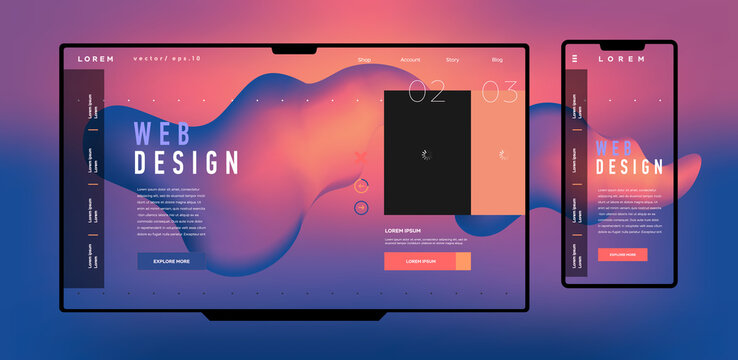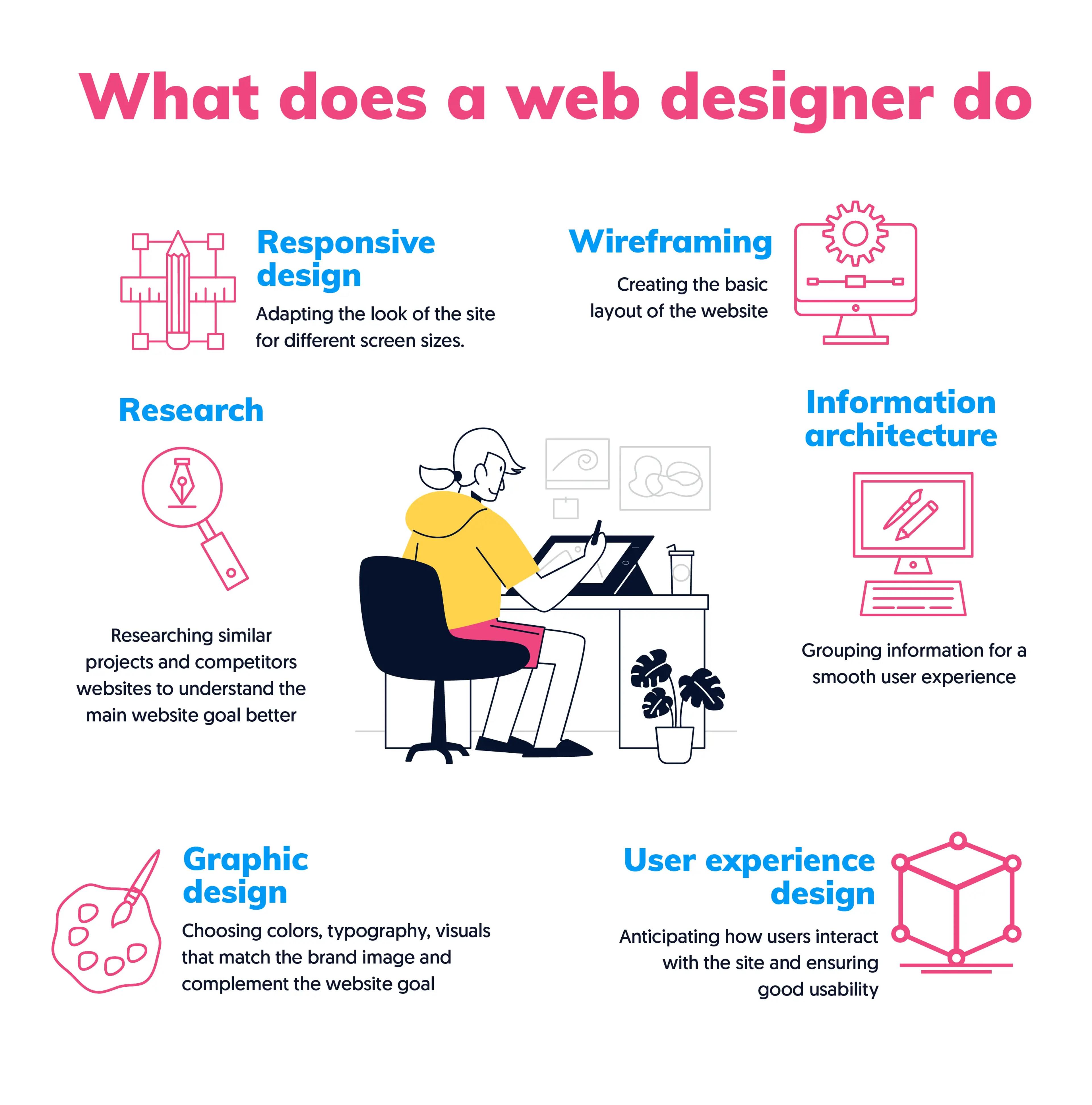Web Design London Ontario Team for Web Expansion
Web Design London Ontario Team for Web Expansion
Blog Article
Recognizing the Crucial Element That Comprise Efficient Web Layout Approaches
Recognizing the vital components can make all the distinction in user involvement and satisfaction when it comes to web layout. You require to consider elements like user-friendly navigation and responsive design to produce a smooth experience. That's just the beginning. Each component plays an essential duty in guiding customers via your material and affecting their behavior. Curious about what really drives these approaches? Let's discover deeper right into these vital components.
The Importance of Customer Experience (UX) in Website Design
Customer experience (UX) is the backbone of effective web layout, forming exactly how site visitors communicate with your site. When you focus on UX, you develop a room where individuals really feel comfortable, engaged, and valued. A well-designed UX warranties that your target market can easily browse your material, discover information swiftly, and appreciate their overall experience.You needs to consider your users' choices and demands, as this understanding directly influences their contentment. By focusing on aspects like lots times, mobile responsiveness, and ease of access, you boost their experience considerably.Moreover, a favorable UX fosters count on and encourages repeat check outs, which can result in higher conversion rates. Remember, customers won't wait to leave your website for a rival if they experience aggravation or complication. Inevitably, investing in UX isn't nearly appearances; it has to do with developing a user-centric layout that keeps site visitors coming back for more.
Crafting User-friendly Navigating for Seamless Surfing
When creating a web site, crafting instinctive navigating is essential for guaranteeing visitors can discover what they require without stress. Beginning by organizing your material practically; team associated web pages together to aid individuals forecast where to locate details. Use clear, succinct tags for navigating links, avoiding jargon that may puzzle your audience.Consider executing an ordered framework with a major menu and dropdowns for subcategories, making it very easy to pierce down into certain subjects. Include a search bar to empower customers to find material directly, particularly on larger sites.Don' t ignore mobile users; ascertain your navigation stays obtainable on smaller sized displays. Maintain it easy and regular across all web pages to strengthen experience. By concentrating on these aspects, you'll develop a smooth browsing experience that maintains visitors involved and motivates them to discover more of what you have to provide.
Receptive Design: Adjusting to Different Gadgets
As the range of gadgets individuals utilize to access the web remains to grow, guaranteeing your website is receptive has actually never ever been more crucial. A receptive style implies your website adapts flawlessly to different screen dimensions, from smartphones to desktops, supplying a premium watching experience. This versatility not just improves customer fulfillment but also increases your site's performance in internet search engine rankings.To develop a receptive style, use adaptable grids and layouts that automatically get used to the screen's dimensions. Apply CSS media queries to tailor designs based upon device characteristics. Focus on crucial content, guaranteeing it's conveniently accessible on smaller sized screens without frustrating customers.
The Duty of Visual Power Structure in Effective Layouts
Visual pecking order is crucial for assisting your target market's interest where it matters most. By properly using centerpieces, typography, color, and contrast, you can develop a format that communicates your message clearly. Let's check out exactly how these aspects interact to boost your style.
Importance of Focal Points
Centerpieces are necessary in internet style, directing customers' interest to the most important aspects on a page. By purposefully positioning these prime focus, you develop a clear aesthetic pecking order that improves customer experience. Think regarding what you desire your visitors to notice first-- whether it's a call-to-action switch, a key picture, or considerable information.Using placement, dimension, and comparison, you can draw attention to these focal points, making them stand apart. Bear in mind, the extra popular the focal factor, the most likely users are to involve with it. A well-designed design not just records rate of interest yet additionally leads customers with your material perfectly, guaranteeing they soak up the details that matters most. Prioritizing centerpieces is vital for reliable interaction on your website.
Shade and Comparison Use
Efficient use color and comparison can substantially influence exactly how individuals view your internet site's material. By picking a color scheme that aligns with your brand, you create a psychological link with site visitors. High comparison in between message and background enhances readability, ensuring your message sticks out. Usage contrasting shades to highlight crucial aspects, like call-to-action switches, assisting individuals' attention where it matters most.Additionally, balance is key; way too much contrast can be frustrating, while inadequate may make your material unseen. Carrying out an aesthetic power structure with shade aids users navigate your website without effort. You desire them to conveniently compare headings, subheadings, and body text, which boosts their general experience. Ultimately, reliable color and contrast usage maintains customers involved and motivates them to check out even more.
Typography's Effect on Design
While it's simple to ignore, typography plays an important duty in forming your site's layout and general user experience. It develops a visual power structure that guides site visitors through your content. By selecting the right font styles, sizes, and designs, you can highlight essential details and produce a seamless flow. As an example, using larger headings assists customers quickly recognize sections, while smaller sized body message provides thorough understandings without overwhelming them. Constant typography not just boosts readability yet also strengthens brand identification. Keep in mind to stabilize attractive fonts with clarity to keep professionalism and reliability. Inevitably, reliable typography warranties your message resonates, making your web site more user-friendly and interesting. Prioritizing this component can substantially boost your style approach and influence.
Utilizing Engaging Material to Involve Site Visitors
Just how can you maintain your site visitors involved and returning for more? The response depends on compelling content. Beginning by understanding your target market and what interests them. Produce informative posts, fascinating stories, or entertaining videos that resonate with their needs. Use a conversational tone to make your web content relatable; it needs to seem like a pleasant conversation instead than a lecture.Incorporate visuals like videos, infographics, and photos to separate text and maintain things vibrant. Do not forget to invite communication-- ask inquiries, motivate comments, or include surveys to spark discussions.Also, focus on clarity and brevity. Make certain your bottom lines shine through without unnecessary lingo or fluff. Bear in mind, quality over amount matters; it's much better to have less, high-impact pieces than a multitude of sub-par ones. Ultimately, when your material's engaging, site visitors will certainly not just linger but also share it with others.
The Impact of Color Psychology on User Interaction
Think about exactly how they can affect individual feelings and assumptions when you select colors for your site. Colors can enhance your brand identification while also guaranteeing ease of access via comparison. Comprehending these components can substantially boost customer interaction and involvement.
Shade Meanings and Emotions
Comprehending shade psychology is necessary for producing an interesting website design, as the shades you pick can affect and evoke specific feelings user communications. Different colors can activate different sensations; as an example, blue commonly conveys depend on and calmness, while red can evoke excitement or necessity. When you incorporate these shades attentively, you direct your customers towards wanted activities. Yellow can motivate optimism and happiness, making it effective for telephone calls to activity, while eco-friendly advertises relaxation and a connection to nature. By straightening your shade scheme with the emotions you wish to evoke, you boost customer experience. Consider your target market and the message you desire to share, guaranteeing your color selections resonate and produce an enduring effect.
Brand Identification Via Colors

Shade Contrast and Accessibility
While choosing a color palette is essential, guaranteeing ample comparison is essential for ease of access. You desire your web site to be visually appealing, but it should also deal with all users, including those with aesthetic problems. High contrast between message and history enhances readability, making it easier for everybody to engage with your content.Think regarding shade psychology, too. Various shades stimulate various emotions and responses. By recognizing how shades impact customer communication, you can lead users toward wanted actions. As an example, making use of cozy colors can produce necessity, while trendy colors may infuse peace. Always test your color combinations to validate they satisfy accessibility criteria, assisting you develop an inclusive experience that resonates with all site visitors.
Enhancing Load Rate for Enhanced Efficiency
Given that users expect web sites to fill quickly, optimizing tons rate is crucial for improving performance and customer contentment. A slow-loading website can irritate visitors and drive them away, so you require to do something about it. Beginning by pressing pictures and making use of modern formats like WebP. This can considerably decrease data dimensions without compromising quality.Next, decrease HTTP requests by incorporating CSS and JavaScript data. Less requests indicate quicker tons times (website design london Ontario). Implementing careless loading for pictures and videos warranties that web content tons only when customers scroll down, improving first blog here tons speed.Additionally, utilize browser caching to save frequently accessed resources, enabling repeat visitors to delight in quicker packing times. Lastly, choose a trustworthy holding company. Their performance straight impacts your website's speed
Frequently Asked Concerns
Exactly How Can I Gauge the Efficiency of My Website Design Method?
To measure your website design technique's performance, track customer interaction metrics like bounce prices, conversion prices, and typical session period. Use tools like Google Analytics to collect insights and adjust your method based upon the information.
What Prevail Errors to Stay Clear Of in Website Design?
In internet design, stay clear of chaotic layouts, inconsistent font styles, and slow-moving packing times (website design london Ontario). Do not disregard mobile responsiveness or overlook individual screening. Prioritize availability and warranty clear navigation to enhance user experience and keep visitors involved
Just how Frequently Should I Update My Site Style?
You need to upgrade your internet site layout every 1 to 2 years, or whenever substantial adjustments happen in your brand or sector. Routine updates keep your website fresh, improve customer experience, and boost functionality.

What Equipment Can Assist Analyze User Actions on My Site?
To analyze user habits on your site, you can use tools like Google Analytics, Hotjar, or Crazy Egg. They'll give insights right into customer interactions, assisting you make informed decisions for improving your website's performance.

Just how Do I Pick the Right Font Style for My Website?
Choosing the appropriate font style for your web site includes taking into consideration readability, design, and alignment with your brand. Try out various typefaces, verify they're legible on various tools, and maintain consistency throughout your web pages for a natural appearance. Integrate a search bar to encourage customers to locate material straight, especially on bigger sites.Don' t forget regarding mobile individuals; identify your navigation continues to be available on smaller sized screens. Effective usage of navigate to these guys shade and contrast can substantially influence just how customers regard your internet site's material (website design london Ontario). Understanding shade psychology is crucial for creating an engaging web style, as the shades you pick can evoke particular emotions and influence user communications. By recognizing exactly how shades impact individual interaction, you can assist customers towards desired actions. Considering that individuals expect internet sites to load rapidly, enhancing tons rate is crucial for boosting performance and user satisfaction
Report this page